Table of contents
- How to find the right lawn plan
- How to fertilize
- How do I know what grass to grow?
- How to overseed
- How to apply weed killer
- How to mow grass
- Dos and don't of mowing
- How to water your lawn
- Watering methods
- Watering based on location
- Watering best practices
- How to dethatch
- How to aerate
- Aeration test
- What to do if your lawn needs aeration
- Insider tips
How to find the right lawn plan
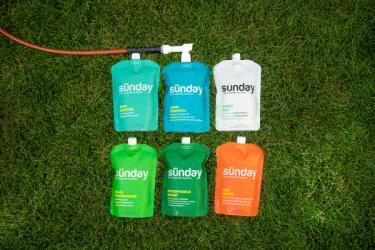
Finding the appropriate plan can feel confusing and daunting. The lawn-care aisle is full of harsh chemicals, and a professional service is expensive. Plus, hauling around those huge bags of fertilizer isn't exactly our idea of a fun weekend. That's why we invented a new kind of lawn care–one that's rooted in science, and safe for kids and pets. In fact, at Sunday, we use soil and climate data to pinpoint your lawn's needs. Then, we deliver the custom lawn nutrients your grass needs, straight to your door. Really, it's that simple. All you have to do is hose it on.
Ready for a custom plan?
Our lawn engine uses satellite data to map out your lawn size and determine things like average rainfall, common weeds, and pest activity.
How to fertilize
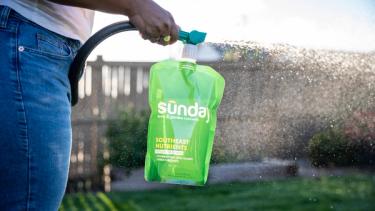
Once you've signed up for your custom lawn plan, we'll ship you the exact nutrients your lawn needs, when it needs it. Once it arrives at your door, it's time to start applying. This process is quick and simple–you should only need about 15 minutes to apply each pouch. Remember, the number of pouches you receive depends on the size of your lawn. So you may just receive one, and that's okay!
To apply your nutrients:
- Insert the straw into the sprayer
- Attach your hose to your nutrient pouch
- Turn on your hose and open the nutrient valve
- Spray in even strokes across your entire lawn
- If possible, move quickly to cover your full lawn once
- If you have more than one pouch, retrace your steps until all pouches are used
- That's it! Make sure to save your sprayer for next time
If you aren't able to apply right away, or there's more than ½ inch of rain in the forecast, that's okay—you can apply at a later date. Just make sure you wait at least a week between applications. Your lawn will green up before you know it.
How do I know what grass to grow?
Not all grass is the same—but luckily, finding grass seed that will thrive is as simple as looking at a map. If you live in the north, you want to grow cool-season grass that enjoys cold winters and mild summers. If you live in the south, you’ll grow warm-season grass that soaks up the sun Sheryl Crow–style.
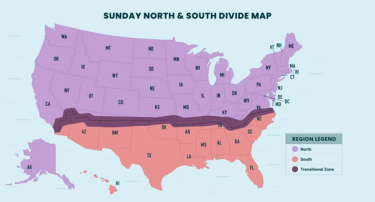
Cool-season grasses:
Tall fescue (turf-type)
Perennial ryegrass
Bentgrass
Warm-season grasses:
Buffalograss
Centipedegrass
Kikuyugrass
Sunday Tip:
Live in the middle of the country? You're in the transition zone, and you can grow either type. Does your grass maintain its green color throughout the colder months? It's probably cool-season. If it turns golden or brown in the winter months it's likely warm-season.
How to overseed
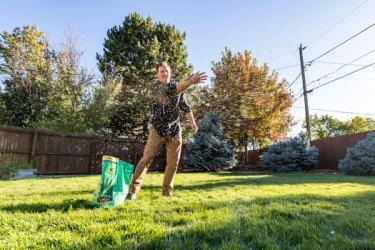
Overseeding your lawn is a great way to help thicken up your grass and repair it after the heat of summer—in fact, it's the best way to reduce weeds in your lawn. And, it's easier to do than you might think. Check out these simple steps:
- Make sure you get the right grass seed blend.
- Mow just a little shorter than usual.
- Spread seed over your lawn, either by hand or with a spreader.
- Keep the soil moist while the seed takes root.
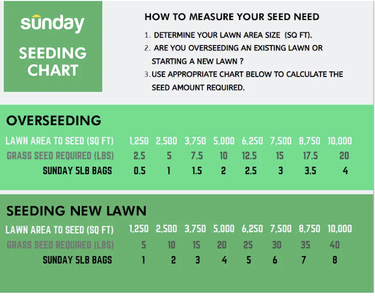
How to apply weed killer
If you notice weeds sprouting up in your lawn, the best way to deal with them is to roll up your sleeves and start pulling. Pulling weeds by hand is a budget-friendly method of weed control that helps remove competition for the nutrients, sunlight, and water your grass needs to grow.
If hand-pulling just isn't going to cut it, Sunday's weed control products are effective and simple to use. They're also made without harsh chemicals typically found in traditional weed control. Just spray it on and take a break while it dries!
To apply
- Look for weeds that have leaves, rather than grass-like blades–these are called broadleaf weeds!
- Shake well before using.
- Thoroughly spray weeds. Use a coarse nozzle setting to reduce drift.
- For stubborn weeds, repeat application after two to three weeks.
Note: Dandelion Doom kills weeds, not lawns!
To apply
- Shake well before using.
- For smaller weeds, spray weeds thoroughly, ideally before they reach 5 inches in height, and when the weather is warm and dry.
- For larger or deep-rooted weeds (e.g. dandelions), split the top of the root and spray the damaged root thoroughly 20 times.
- For best results, repeat treatment in three to four weeks.
Note: Apply carefully—Weed Warrior is an OMRI-listed organic herbicidal soap, and it kills grass. This makes it ideal for use in flower beds, near patios, along sidewalks, and in mulched areas. Just keep it away from your lawn!
How to water your lawn
It's simple: your lawn needs water to survive, and grass does best when the water soaks down into the root zone. But when and how should you do this? And, how can you avoid common watering mistakes? Check out these best practices and expert tips to become a watering pro in no time.
Watering methods
First, let's check out the different ways you can choose to water your lawn. Each method has its own pros and cons.
Hand watering with a hose and nozzle
Pros: This allows the most control over where and how much you're watering.
Cons: Depending on your lawn size, it can be time-consuming and impractical.
Above-ground sprinkler attachments
Pros: These require less work than manual watering and are cost-effective. Plus, they're able to cover more of an area at once.
Cons: They don't have the best uniformity, and you may have to move yours around the lawn during a watering session to reach all of your grass.
In-ground sprinklers
Pros: These don't require much work, since they're automatic. They also can water each section—or "zone"—of your lawn differently, which prevents your grass from getting too much or too little water.
Cons: Even though they're efficient, improperly installed systems can lead to water waste. They also require maintenance during changes in the weather, like rain, intense heat or drought, and freezes.
Smart sprinkler systems
Pros: These use timers and weather sensors to make sure your grass gets exactly the right amount of water. Their overall efficiency reduces waste and saves you money over time.
Cons: They are more expensive up front.
Watering based on location
Once you've decided on the method you'd like to use, it's time to figure out when and how often to water your lawn. Generally speaking, you'll want to water your lawn more in the summer, and a little less in the spring and fall. But to get even more specific about when to water, we'll have to take a look at the different parts of the U.S.
- For those who live East of the Mississippi, there's a good chance your lawn gets enough rain throughout the year, and it doesn't need much help. You'll probably just need to turn on the water in June, July, and August, when summer's at its peak.
- If you live West of the Mississippi, you're probably familiar with drier conditions, which you may experience all year, or at the very least, during the growing season. You'll likely need to supplementally water all throughout the year to sustain your lawn.
Watering best practices
These tips are important to keep in mind no matter where you live.
- If rain's in the forecast, take advantage of it and don't water
- Shady spots likely need less water, sunny spots may need more
- To maximize efficiency and reduce the risk of damage or disease, the best time to water is between 6 a.m. and 10 a.m.
- Watering at night between 10 p.m. and 6 a.m. is the second-best time, and is better for cutting back on how much water your lawn needs
- If you have a slope in your lawn, water from the top until you start to see runoff—then stop
- You may need to stop and start this process a few times to make sure the top doesn't get too dry, and standing water doesn't flood the bottom
How to mow grass
Mowing is important. Not only does it help you maintain a beautiful yard, it actually helps keep your grass healthy by outcompeting weeds and filling in bare spots—and even gets rid of some pests commonly found in lawns. But there's more to it than revving up your machine and pushing it along. Here are a few mowing dos and don'ts to help you learn how to mow a lawn.
Do:
- Sharpen your mower blade. Sharp mower blades keep your grass beautiful and protect it from becoming torn, shredded, and vulnerable to disease.
- Mow when your grass is dry. Cutting dry grass keeps your mower deck unclogged and helps keep the cut even.
- Mow high. Short grass is stressed. Check out this mowing height chart to help figure out where to set your mower.
- Mow regularly. Only cut off a third of your grass blade at a time. This protects your grass from weakening or getting stressed.
- Grasscycle. Leave grass clippings where they fall when you mow your lawn. This is called "grasscycling” and it's a free way to give your lawn nutrients.
- Adjust based on season. Let your grass grow a bit longer in the summer to help prevent weeds and help with heat stress.
Don't:
- Cut your lawn too short. Don't take off more than ⅓ of the grass length each time you mow.
- Mow your lawn every week. Don't mow too frequently–really! Mowing less can stop your grass from stressing, and help it become more self-sustaining.
- Mow during peak hours of the day. Avoid mowing between 10 a.m. and 2 p.m. Otherwise, your grass will lose more water and won't recover as quickly!
- Mow right after seeding. Wait until your new grass is about two inches tall before mowing again.
- Mow stressed grass. If your region is experiencing a lot of drought or heat, reduce mowing until conditions level out again.
How to dethatch
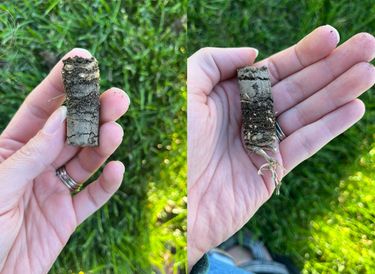
Do you notice an undergrowth layer of stems and roots between your lawn and the surface of your soil? If so, you probably have thatch.
A little bit of thatch is a good thing. In fact, it actually helps your grass keep in moisture, and protects your lawn against big temperature swings.
But if there's too much thatch—more than 1 inch—you might not be able to grow new grass, and your existing lawn might not get the oxygen it needs to stay healthy and strong. In this case, it's time to dethatch your lawn.
You can dethatch in these straightforward steps:
- Make sure you have a legitimate issue. Remember, thatch can be helpful. But if you notice more than an inch of thatch that's tightly woven together, or it's more tan than green, it's time to get to work.
- Mow your grass as you normally would. You don't need to change your mowing height. Just make sure to bag the clippings instead of leaving them.
- Rake away some thatch. You don't want to get rid of all of it, and you don't need a special dethatching rake. Just grab a regular rake and use it to pull thatch up and away. Don't be too aggressive, as it can damage your grass.
- That's it. You're all done. Keep an eye on thatch levels moving forward and repeat in the future if you notice it accumulating again. And, when you're finished, don't forget to enjoy your day–you've just accomplished something amazing! Healthy lawns for the win.
How to aerate
You've probably heard the word "aeration" before, or maybe you've noticed grass with "plugs" on it in your local park. But what is aeration, exactly? And how do you aerate a yard?
In short, it's a way to break up your lawn's surface layer. Doing so can help your grass get the water, drainage, and oxygen it needs. In general, though, we don't feel it's necessary to make core aeration a routine practice. In fact, our goal is to leave your lawn's soil as undisturbed as possible. But sometimes, aeration is essential—especially if you've got highly compacted soil in high-traffic areas in your lawn.
Wondering if you've got compacted soil? There's an easy way to find out.
Aeration test
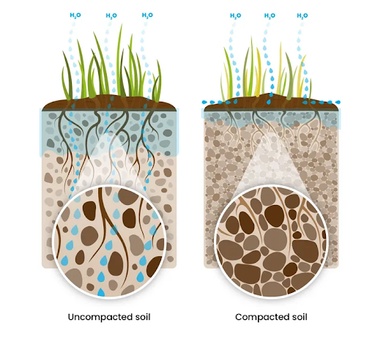
If you are concerned about soil compaction, the test is easy. Just get a screwdriver—it doesn't matter what kind. All you have to do is insert the head into moist soil. If it's difficult to stick your screwdriver in there, you've likely got compacted soil. Unfortunately, if the soil compaction is severe—i.e. it's very difficult or impossible to insert the screwdriver—core aeration isn't enough, and you likely need your soil amended.
What to do if your lawn needs aeration
We typically don't recommend aeration for a few reasons:
- It unnecessarily disturbs healthy soil
- It can bring up undesirable weed seeds
- It affects a small part of lawn surface
- Your soil frequently settles back to the same bulk density in 8-10 weeks, especially in high-traffic areas
Can I aerate my lawn by myself?
If you're sure you need aeration, and you've got a small lawn, you can likely get it done with a manual tool. But if you've got a larger lawn, we recommend either renting a machine from a local home improvement store or bringing in a professional.











